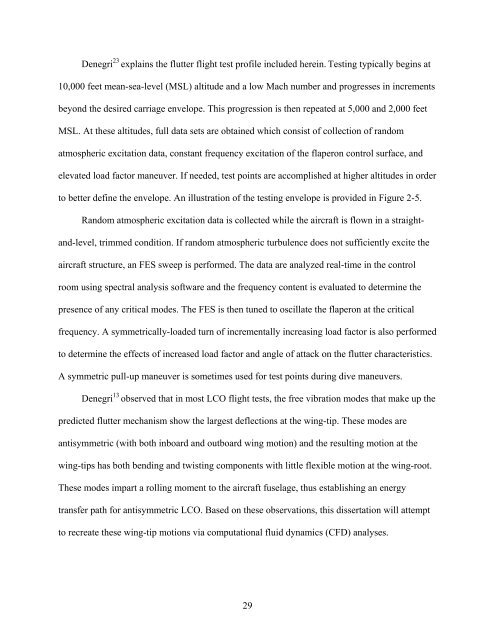university of florida thesis or dissertation formatting template
university of florida thesis or dissertation formatting template
university of florida thesis or dissertation formatting template
You also want an ePaper? Increase the reach of your titles
YUMPU automatically turns print PDFs into web optimized ePapers that Google loves.
Denegri 23 explains the flutter flight test pr<strong>of</strong>ile included herein. Testing typically begins at<br />
10,000 feet mean-sea-level (MSL) altitude and a low Mach number and progresses in increments<br />
beyond the desired carriage envelope. This progression is then repeated at 5,000 and 2,000 feet<br />
MSL. At these altitudes, full data sets are obtained which consist <strong>of</strong> collection <strong>of</strong> random<br />
atmospheric excitation data, constant frequency excitation <strong>of</strong> the flaperon control surface, and<br />
elevated load fact<strong>or</strong> maneuver. If needed, test points are accomplished at higher altitudes in <strong>or</strong>der<br />
to better define the envelope. An illustration <strong>of</strong> the testing envelope is provided in Figure 2-5.<br />
Random atmospheric excitation data is collected while the aircraft is flown in a straight-<br />
and-level, trimmed condition. If random atmospheric turbulence does not sufficiently excite the<br />
aircraft structure, an FES sweep is perf<strong>or</strong>med. The data are analyzed real-time in the control<br />
room using spectral analysis s<strong>of</strong>tware and the frequency content is evaluated to determine the<br />
presence <strong>of</strong> any critical modes. The FES is then tuned to oscillate the flaperon at the critical<br />
frequency. A symmetrically-loaded turn <strong>of</strong> incrementally increasing load fact<strong>or</strong> is also perf<strong>or</strong>med<br />
to determine the effects <strong>of</strong> increased load fact<strong>or</strong> and angle <strong>of</strong> attack on the flutter characteristics.<br />
A symmetric pull-up maneuver is sometimes used f<strong>or</strong> test points during dive maneuvers.<br />
Denegri 13 observed that in most LCO flight tests, the free vibration modes that make up the<br />
predicted flutter mechanism show the largest deflections at the wing-tip. These modes are<br />
antisymmetric (with both inboard and outboard wing motion) and the resulting motion at the<br />
wing-tips has both bending and twisting components with little flexible motion at the wing-root.<br />
These modes impart a rolling moment to the aircraft fuselage, thus establishing an energy<br />
transfer path f<strong>or</strong> antisymmetric LCO. Based on these observations, this <strong>dissertation</strong> will attempt<br />
to recreate these wing-tip motions via computational fluid dynamics (CFD) analyses.<br />
29
















